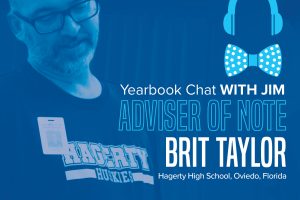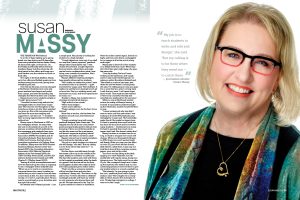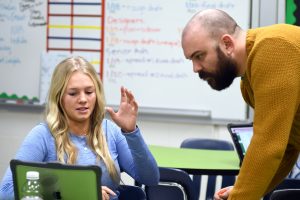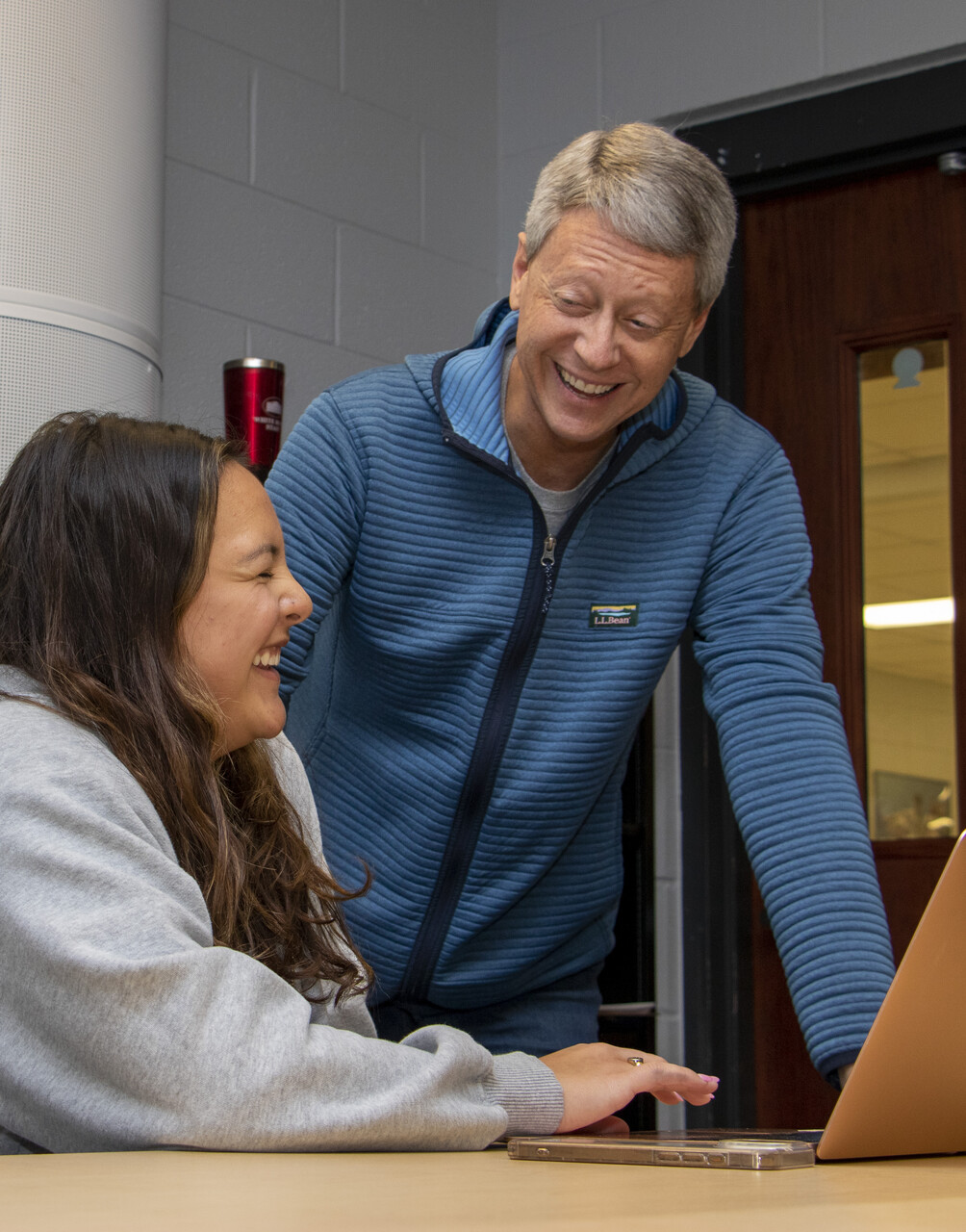
Yearbook Advisers of Note: Meet Jim McCrossen
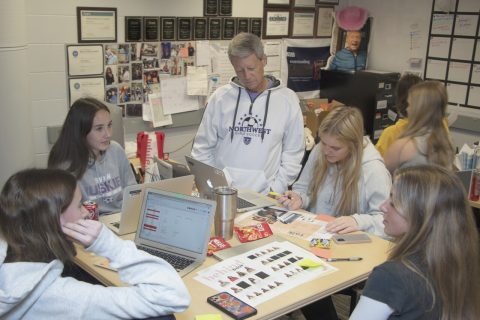 Jim McCrossen is a mild-mannered yearbook adviser at Blue Valley Northwest High School in Overland Park, Kansas. Behind his gentle demeanor is a person with a wealth of interesting life experiences and a passion for making the world a better place. One way he works to improve the world around him is through his role as a teacher and scholastic journalism adviser. After working as a photojournalist in southern California during the 80s – where he covered things like the 1984 summer Olympics, President Ronald Reagan and a visit from the Pope – McCrossen moved back to his home state of Kansas to pursue a teaching degree. He’s been at Blue Valley Northwest since it opened 30 years ago, and the insights he’s gained about teaching and yearbooks are invaluable.
Jim McCrossen is a mild-mannered yearbook adviser at Blue Valley Northwest High School in Overland Park, Kansas. Behind his gentle demeanor is a person with a wealth of interesting life experiences and a passion for making the world a better place. One way he works to improve the world around him is through his role as a teacher and scholastic journalism adviser. After working as a photojournalist in southern California during the 80s – where he covered things like the 1984 summer Olympics, President Ronald Reagan and a visit from the Pope – McCrossen moved back to his home state of Kansas to pursue a teaching degree. He’s been at Blue Valley Northwest since it opened 30 years ago, and the insights he’s gained about teaching and yearbooks are invaluable.
You can listen to the podcast at walsworthyearbooks.com/podcasts or find it on Spotify, iTunes or wherever you get your music.
Profile
High school attended – Ottawa High School, Ottawa, Kansas. Ottawa is a small town of about 12,000 people approximately 45 minutes south of Kansas City.
College attended + degrees and majors – I have a Bachelor of Science degree in Journalism from the University of Kansas and a master’s degree in education from MidAmerica Nazarene University.
Did you participate in journalism in high school?
I was on my high school newspaper staff as a photographer. I also took photos for the yearbook, but I was actually on the newspaper staff. Working in the darkroom processing film and printing the photos was my creative break in the day. I loved every minute of it. My high school journalism teacher is still one of my very dear friends. She was so influential in my life and in my decision to major in photojournalism in college.
Did you participate in journalism in college?
I was a photojournalist for the University Daily Kansan, the college newspaper at KU. I got the job when the newspaper sent one of their staff photographers to Los Angeles to shoot the KU vs UCLA football game and he decided he wanted to stay in California. He never came back so there was an opening. I quickly started getting better and better assignments by working my backside off to prove myself to the editors. The best assignments were shooting KU basketball games. Being courtside shooting one of the top basketball programs in the country was such a great experience. This was when all photography was done on film so you would shoot the game, run up the hill to campus and process the film, print a photo and turn it in to the sports editors with a properly written cutline. This was done very quickly to make the deadline for the printer. It was so much fun and such a great learning experience.
Were you ever a professional journalist or professional photographer? I was hired by a daily newspaper in Southern California before I graduated from college. I had an interview with the president of a newspaper chain. They were based in Kansas but had newspapers all over. He looked over my portfolio and said the only opening they had was in California. I told him I was flexible in where I went after I graduated. He called the California newspaper’s publisher who told me to be on a plane that weekend to LAX for an interview. They put me to work to see if I could handle the job. Before I left Sunday night, they made me an offer. I worked there for five years as a staff photographer, chief photographer, photo editor and then finally photo and graphics editor. The 1984 summer Olympics was in Los Angeles my first summer working and that was one of my first assignments. I didn’t get the premiere gigs like gymnastics – I got the rowing sports – but it was still the Olympics. I was able to travel on the team plane with the Los Angeles Raiders. I was able to photograph President Reagan often since he came out to his ranch quite a bit. I photographed Pope John Paul II when he came to L.A. I was able to photograph celebrities, concerts – all kinds of exciting events in the L.A. area. It was an amazing job, and I was having the time of my life, but I didn’t find it very fulfilling. I wanted to feel I was making a significant difference in people’s lives.
Details
Size of your book: 9
Number of pages in your book in 2022: 464
Number of pages in your book in 2023: 424
InDesign
Delivery: Spring
Number of books sold in 2022: 1554
Number of books sold in 2023: 1503
Awards for 2022 and previous books Our 2022 book is a Pacemaker Finalist, and our 2021 book was a Pacemaker winner. The editors have never entered their work in the CSPA contests. We fairly consistently are All-Kansas Yearbook winners from the Kansas Scholastic Press Association.
Number of books you have advised at Blue Valley Northwest High School including the 2023 book? This, the 2023 yearbook, is my 30th yearbook at BVNW. That’s also the number of years the school has been around. I’m the only yearbook adviser the school has had.
Other schools you have taught and/or advised at? What years? Awards at previous school? I taught for two years at Blue Valley North before transferring to the new school opening up in 1993, Blue Valley Northwest. I don’t recall any major awards for the books at BVN. I was very proud of the work the students did, however.
Other classes you teach Blue Valley Northwest: The other classes I teach are newspaper (both print and online), 21st Century Journalism, senior English and I am very blessed to have an hour with just my newspaper and yearbook editors. I am also the Career and Technical Education department chair at my school and am the lead journalism teacher for our school district which includes five high schools.
Other publications you advise: The Express, our school newspaper, and BVNWnews.com, our online news publication.
Questions
Where were you born and raised? I was born in Topeka, Kansas, the state’s capital. My dad was the chaplain for the house of representatives and the minister of a church in Topeka. Ottawa was my hometown for kindergarten through high school, where my dad continued to pastor a church and my mom taught English at the high school.
What were you involved in during high school? How would you describe high school Jim?
Music and photojournalism were my main activities in high school. I played cello in the orchestra, flute in the band and was a tenor in our show choir-type group. I was also a class officer and on the golf team (junior varsity, to be honest). Shooting for the newspaper and the yearbook was the highlight of my school day, however. That’s where I found the most joy. High school Jim was probably a little (maybe a lot) ornery. I think I was well liked by my fellow students and teachers, but I know I was a little Eddie Haskell-ish. I see myself as the kid – and every teacher knows this kid – who the teachers liked but also made them bang their head on their desk. I skipped school one afternoon telling my newspaper adviser I was selling ads, but I really just went out to lunch. When my teacher found out, she just told me, in no uncertain terms, how disappointed she was in me for lying. I’ve never forgotten how hurt she was and how bad I felt because of it. I tell my students every year, I can handle you not doing what you were supposed to do, but lying to me will be a much bigger disappointment.
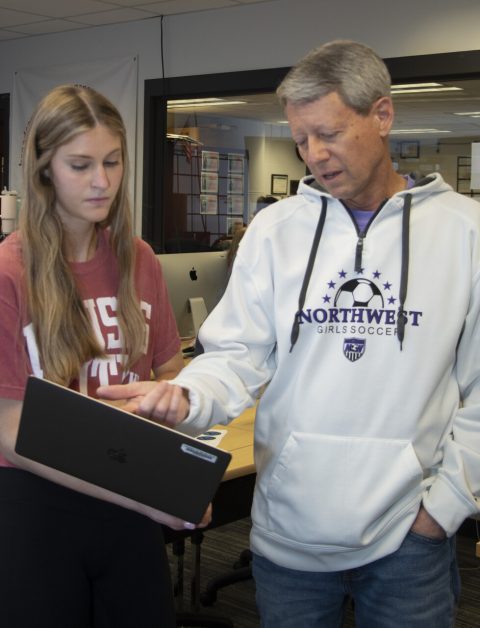 How and why did you decide to go into teaching?
How and why did you decide to go into teaching?
My mom was a high school teacher, and my dad was a religious teacher—you might say it was in my blood. My high school journalism teacher encouraged me to pursue photojournalism in college, and I worked for a daily newspaper for five years after college, but I wanted something more fulfilling in my vocation. Once I realized I could have the best of both worlds—have one foot in the journalism world and one in the education world – I knew what I needed to do. I went back to school to get my teaching license and have never looked back.
How and why did you first get involved with scholastic journalism?
It was my high school journalism teacher. I knew I wanted to be like her. She taught me so much more than journalism, and I wanted to continue to do that for others.
How did you first get involved in photography? How did you learn the craft and become more than proficient at it?
My maternal grandfather was an amateur photographer and had a darkroom in his house. I was always intrigued by the darkroom but wasn’t allowed into it until I got to junior high. Once I saw him work at printing photos, I was hooked. He gave me a camera and taught me how to use it and how to process film and print photos so by the time I got to high school, I was able to get right to work shooting and producing photos for the publications.
What were the circumstances around you becoming an adviser?
I got into teaching to advise yearbook and newspaper. My first job came about after student teaching at Blue Valley North because the newspaper and yearbook adviser, who I did part of my student teaching with, told the administration she was no longer interested in advising the yearbook, so the school was forced to hire me. I taught sophomore honors English and advised the yearbook. I am forever grateful to Andrea Wichman for making that sacrifice to assure I had a job. When Blue Valley Northwest opened two years later, the district transferred me there to advise the yearbook, newspaper and teach journalism.
What was the most difficult part of your first year advising?
Actually, my first year was pretty smooth. There weren’t too many difficulties. Andrea, the previous adviser, was still at the school so any issues that came up, I had someone to go to. The difficult year was my second year. I noticed some irregularities with what the bookkeeper was telling me and what my own financial records said. I then started getting notices from Walsworth that our initial payment had not been made. Long story made shorter, I notified the principal of my suspicions. The FBI began an investigation, and that summer was spent with the FBI and their agents and forensic accountants. I was trying to open a brand-new school, but I couldn’t get away from my previous school. I was on the front page of the Kansas City Star as part of the alleged embezzlement investigation. It was sort of a nightmare.
What made you want to come back for year two?
I quite simply had a blast in year one. The late-night worknights, the deadline pressures, the amazing students all came together to make me know I had made the right decision to become a publications adviser.
What advice would you give to a first-year adviser?
There is no such thing as a perfect yearbook—so don’t stress out trying to produce one. Have fun. There just aren’t many classes where the students freely enroll to work their butts off. So, teach them and then get out of their way. The process and product can be painful, or it can be joyful. That decision is yours to make and the students will follow your lead. If you are having fun, the students will also have fun.
What were some of the factors that have led your success as an adviser over the years?
If I have had success, it is due to the students I’ve had, the administrators I’ve had, and the colleagues I’ve had. It’s due to the tightknit journalism community in the Kansas City area and in the state of Kansas. It’s due to amazing advisers who have allowed me to learn from them. It’s due to a strong state association (Kansas Scholastic Press Association). It’s due to a state that has fully supported students’ First Amendment rights since before I started teaching. It’s due to the patience of my wife and children and the insistence of my wife and children that there is more to life than yearbook. It is realizing it’s just a yearbook – it isn’t the end-all, be-all of life.
What has been your biggest challenge as an adviser?
It has been allowing my students to fail – sometimes epically. We learn through failure and if I keep them from failing, they don’t learn. It would be so easy to step in and correct something, or rewrite a story lede, or re-crop or color-correct a photo. It would be really easy to fix all their errors, but I don’t see that as my job. If I taught math, I certainly wouldn’t be correcting my kids’ homework. The book is the yearbook staffs’ homework. It does get published and people pay a lot of money to view their homework, but it’s still the staff’s ability to learn from their errors that is most important. To me, when staff members see their errors and hear feedback from their peers, the lesson is cemented. They won’t make the same mistake ever again.
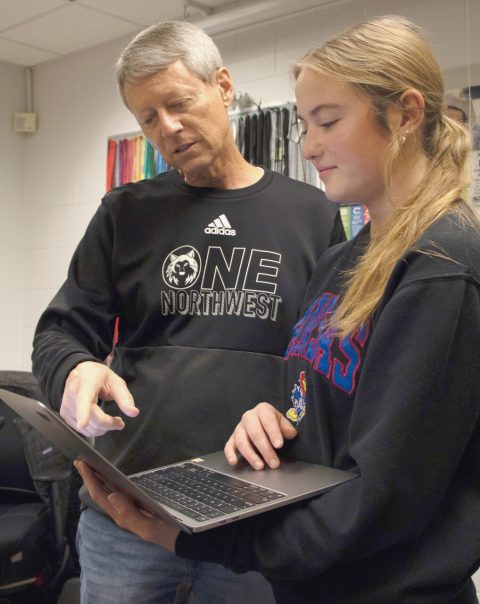 Tell me about something in your life as an adviser that has made you proud.
Tell me about something in your life as an adviser that has made you proud.
One of my editors two years ago was the daughter of a yearbook staff member from earlier in my career. That was a really meaningful moment when I found out. That someone had such a good experience in their time on yearbook that they would want their child to experience something similar. Sure, I felt really old in that moment, but it also was such a meaningful moment.
What keeps you going when things get tough and frustrating?
It might sound trivial, but our Food Friday is a ray of sunshine every week. A couple staff members are assigned to bring food (almost always junk food – some salty, some sweet). No one on staff, me included, can be too down when staring at a table filled with junk food on a Friday afternoon.
Tell a story about a moment in your career as an adviser that you will never forget.
It was a long time ago at a JEA/NSPA convention in Portland, and we had taken the kids – probably around 20 students – somewhere. It was nighttime and we were walking back to the hotel, and one of the kids found a long loaf of French bread with the hard crust and an old ratty tennis ball and we had a pick-up game of baseball in the street using the ball and the bread as a bat. We couldn’t stop laughing, and then we started an impromptu dance party in the street once the bread disintegrated. It was one of my favorite memories of any convention. The kids and adults were all comfortable just being silly for a half hour or so.

